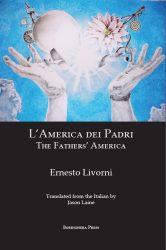 Ernesto Livorni’s book, “The Fathers’ America”
Ernesto Livorni’s book, “The Fathers’ America”Umbra was excited to welcome Professor Ernesto Livorni to present his new book, “The Fathers’ America” to the Umbra Community. Professor Livorni currently teaches LIAH 370: Leonardo da Vinci: Renaissance Man and Modern Myth at the Umbra Institute.
At the beginning of his presentation, Professor Livorni explained that his poems, though they were written about personal and familial immigration to America, are meant to be identifiable across generations, and across nationalities. They are meant to be relatable to those who may have immigrated to Argentina, Australia, or any other country, as immigrants tend to share a special bond that is instantly understood by anyone who has chosen to leave their homeland, for any of a myriad of reasons, to work his/her way into the society and culture of a new, foreign, unknown location.
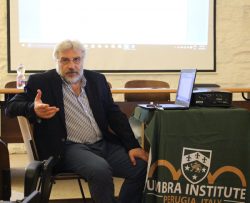
The poetry that comprises “The Fathers’ America” was written while Professor Livorni was a PhD student in America, during the mid-late 80s. He had just published his first collection of avant-garde work, in Italy, and wanted to experiment with more traditional poetry using hendecasyllabic and heptasyllabic meter. At this point, he wrote a number of sonnets and, throughout his work, insisted on using quotidian metaphors and ideas that might cross the mind of the average immigrant mine worker or field laborer.
Professor Livorni closed his presentation by reading a number of the poems published in “The Fathers’ America”, including:
| Il giorno che saprò fare al tuo viso una statua trasparente d’avorio con l’acqua del fiume che bagna, con l’acqua del mare solcato, con l’acqua che sempre mi lava, con l’acqua e nulla piú che l’acqua, quel giorno alla luce piú chiara ti donerò non-ti-scordar-di-me. |
The day that I will know how to make for your face a transparent ivory statue with the water from the river that washes, with the water from the furrowed sea, with the water that ever washes me, with the water and nothing other than the water, that day in the brightest light, to you I will give forgetmenot. |
Should you be interested in purchasing Professor Livorni’s work, click here.


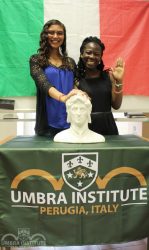 Students swear in for the SoloItaliano Challenge
Students swear in for the SoloItaliano Challenge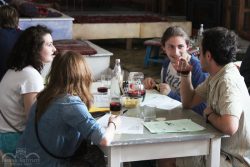
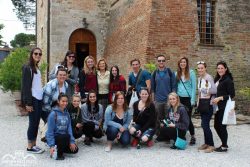 Students pose with Nonna Marcella, author of Goretti’s famous recipe book
Students pose with Nonna Marcella, author of Goretti’s famous recipe book Sawyer presenting the imagery portrayed by cultural symbols throughout time
Sawyer presenting the imagery portrayed by cultural symbols throughout time